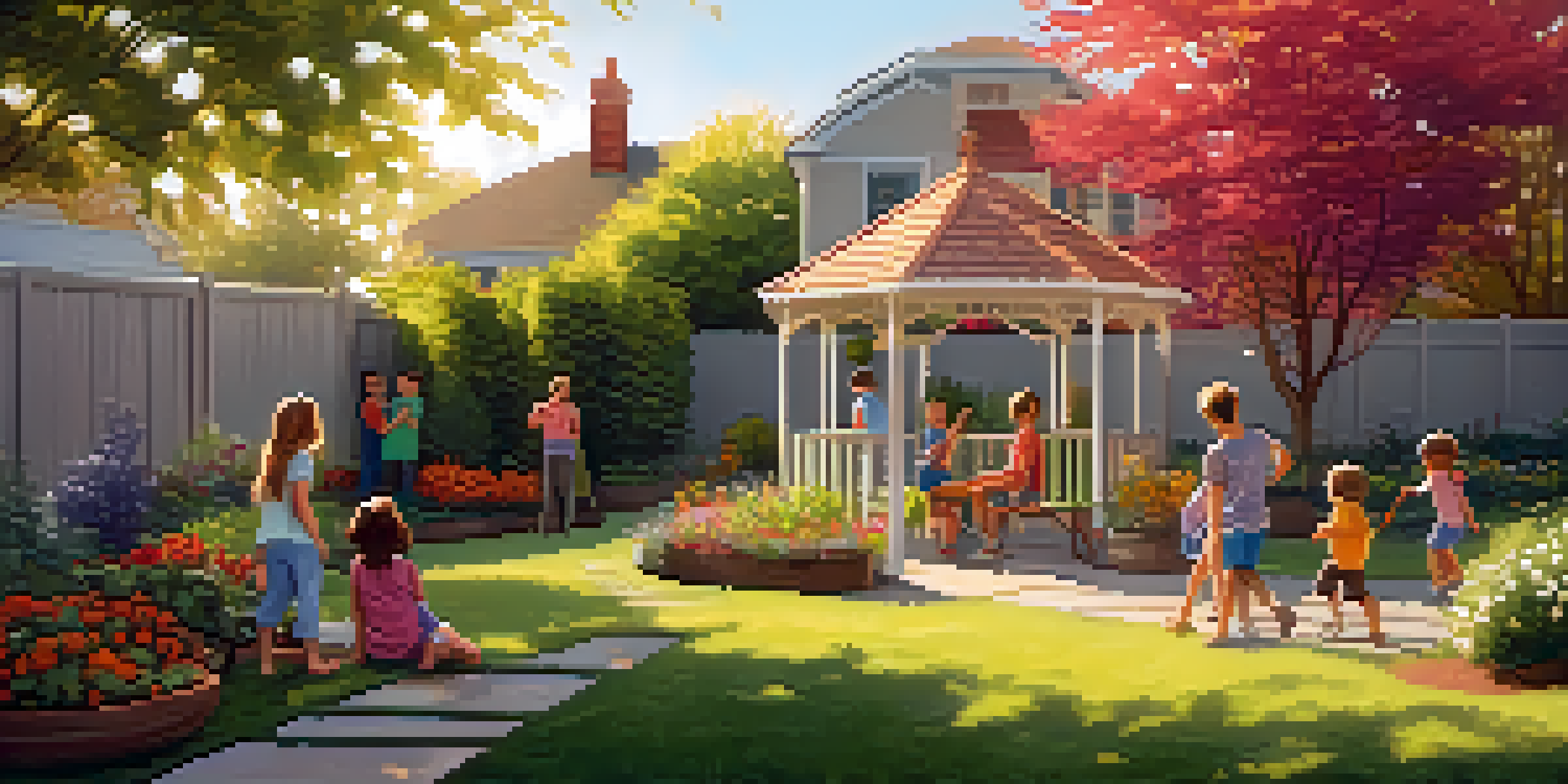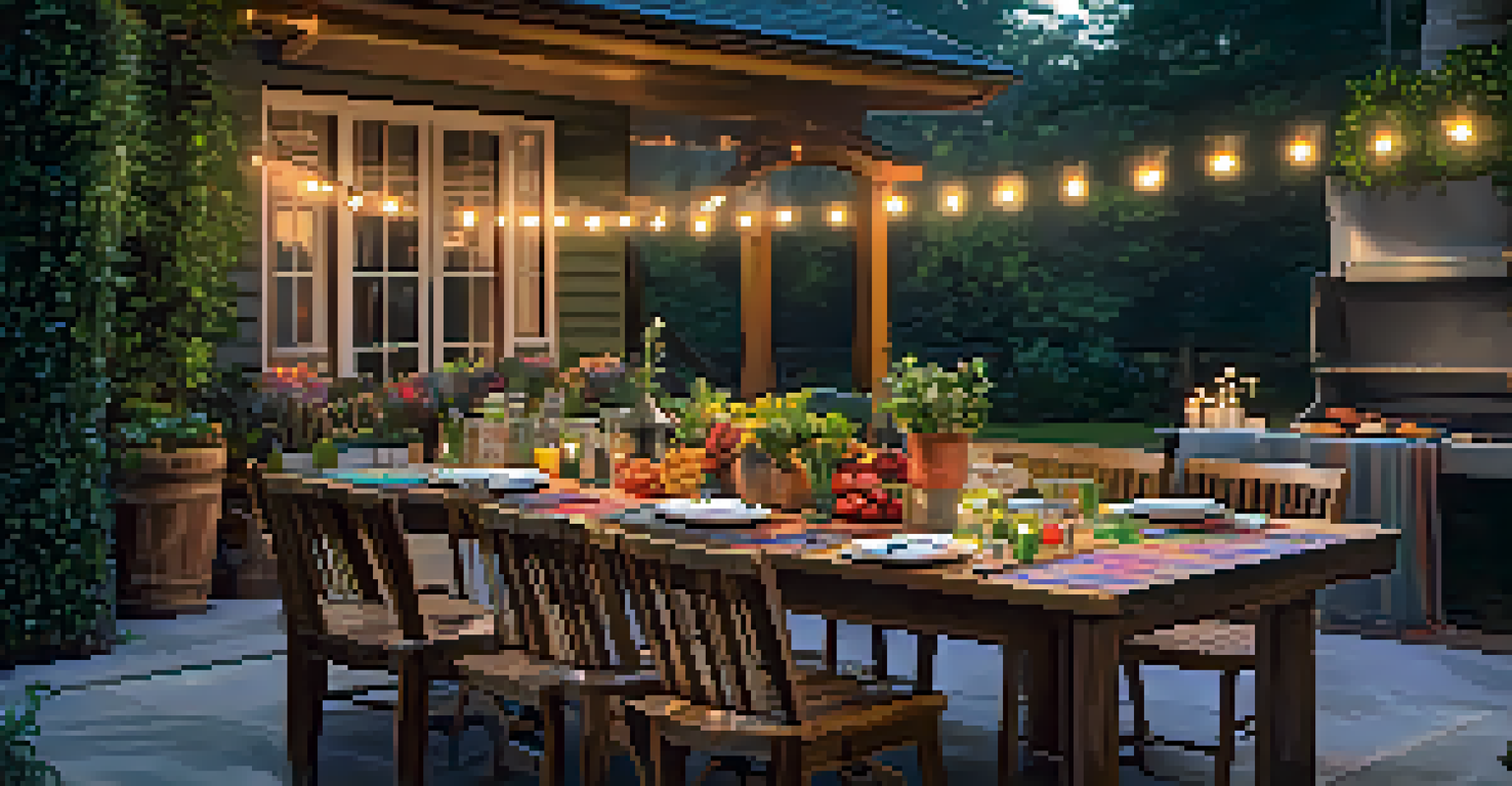How to Create a Family-Friendly Yard with Landscape Design

Understanding the Needs of Your Family in Yard Design
Before diving into landscape design, consider what your family needs from the yard. Are you looking for a play area for the kids, a garden for growing vegetables, or a peaceful space for relaxation? Understanding these needs will guide your design choices and ensure everyone enjoys the space.
The best thing about memories is creating them.
Involving your family in the planning process can be incredibly beneficial. Ask your children what they envision—perhaps a treehouse or a sandbox. This collaborative approach not only makes them feel included but also gives you a clearer picture of how to meet their expectations.
Lastly, think about the future. Your family's needs may change as children grow older, so design a flexible space that can adapt. This could mean creating areas that can serve multiple purposes, like a lawn that can host both playdates and family gatherings.
Choosing Safe and Durable Materials for Your Yard
Safety should always be a top priority when selecting materials for your yard. Opt for non-toxic plants and soft surfaces for play areas to minimize the risk of injury. For instance, rubber mulch or natural grass can provide a safer play environment compared to harder surfaces like concrete.

Durability is also crucial, especially for families with active kids and pets. Select materials that can withstand wear and tear, such as composite decking or weather-resistant furniture. These choices ensure that your investments last as long as your family enjoys them.
Design for Family Needs
Understanding your family's needs helps create a yard that everyone can enjoy.
Finally, consider maintenance. Choosing low-maintenance materials can help you spend more time enjoying your yard rather than constantly working on it. For example, native plants tend to require less water and care, making them ideal for a busy family lifestyle.
Incorporating Play Areas for Kids of All Ages
Designing a yard that includes play areas for kids can enhance family bonding and encourage outdoor activity. A designated space for play equipment, like swings or a slide, can create a fun environment where children can let off steam. Just remember to position these play areas in a safe zone, away from potential hazards.
Nature does not hurry, yet everything is accomplished.
For older kids, consider including features like a sports court or a climbing wall. These elements not only promote physical activity but also provide a space for socialization with friends. A backyard soccer goal or a basketball hoop can transform your yard into a mini sports complex.
Don't forget to add some shaded spots where kids can take a break from the sun. A gazebo or pergola can offer a refuge during hot days, ensuring that playtime is enjoyable and safe. Adding comfortable seating nearby allows parents to relax while keeping an eye on the fun.
Creating Inviting Outdoor Spaces for Family Gatherings
Your yard can be the perfect venue for family gatherings, barbecues, or birthday parties. Consider designing an outdoor dining area with a table and chairs where everyone can enjoy meals together under the sun or stars. Adding a grill or fire pit can elevate these gatherings, making them memorable experiences.
Incorporating comfortable seating areas encourages conversation and relaxation. Whether it's a cozy corner with cushions or a full patio set, having ample seating allows everyone to unwind. A few throw blankets can make it even cozier during cooler evenings.
Choose Safe, Durable Materials
Selecting non-toxic and durable materials ensures safety and longevity for your yard.
Lighting is key to creating an inviting atmosphere for nighttime gatherings. String lights, lanterns, or solar-powered garden lights can add a magical touch to your outdoor space, making it feel warm and welcoming after the sun goes down.
Incorporating Gardens for Learning and Recreation
Gardening can be a fantastic family activity that teaches kids about nature, responsibility, and patience. Consider creating a small vegetable or herb garden where children can help plant seeds and tend to the plants. Watching their hard work pay off can instill a sense of accomplishment and foster a love for healthy eating.
Flower gardens can also be a beautiful addition, providing a sensory experience with vibrant colors and delightful scents. Involve your kids in selecting the flowers and planting them, making it a fun project that beautifies your yard. A butterfly garden can also attract pollinators, adding even more life to your outdoor space.
Remember to include pathways or stepping stones in your garden design to create a sense of exploration. Kids will love wandering through the garden, discovering new plants and insects. This interactive experience not only encourages outdoor play but also deepens their appreciation for nature.
Adding Features for Relaxation and Serenity
A family-friendly yard doesn't just need play areas; it should also be a retreat for relaxation. Consider incorporating a hammock or a comfortable lounge chair where you can unwind with a book while keeping an eye on the kids. This balance of play and relaxation can make your yard a true sanctuary.
Water features, like a small pond or a fountain, can add a calming element to your outdoor space. The sound of flowing water is not only soothing but can also attract birds and other wildlife, enriching your family's connection to nature. Just make sure any water features are safe and supervised, especially for younger children.
Incorporate Relaxation Spaces
Including areas for relaxation balances active play and promotes family bonding in your yard.
Incorporating fragrant plants, such as lavender or jasmine, can enhance the sensory experience in your yard. Their pleasant aromas can turn an ordinary outdoor space into a peaceful retreat. Creating a corner with these plants, perhaps with a bench nearby, can provide a perfect spot for quiet family moments.
Maintaining Your Family-Friendly Yard for Longevity
Once your family-friendly yard is designed, regular maintenance is essential to keep it looking its best. Create a simple upkeep schedule to manage tasks like mowing, watering, and weeding. Involving the whole family in these activities can make maintenance a fun bonding experience.
Consider using organic gardening practices to promote a healthy environment for both your family and local wildlife. This approach not only benefits the ecosystem but also ensures that your kids can safely play and explore without exposure to harmful chemicals.

Lastly, periodically assess your yard's design to see if it still meets your family's evolving needs. As children grow or family dynamics change, you may want to adjust or add features to keep the space enjoyable for everyone. Flexibility in your design will help maintain a yard that continues to be a family favorite.